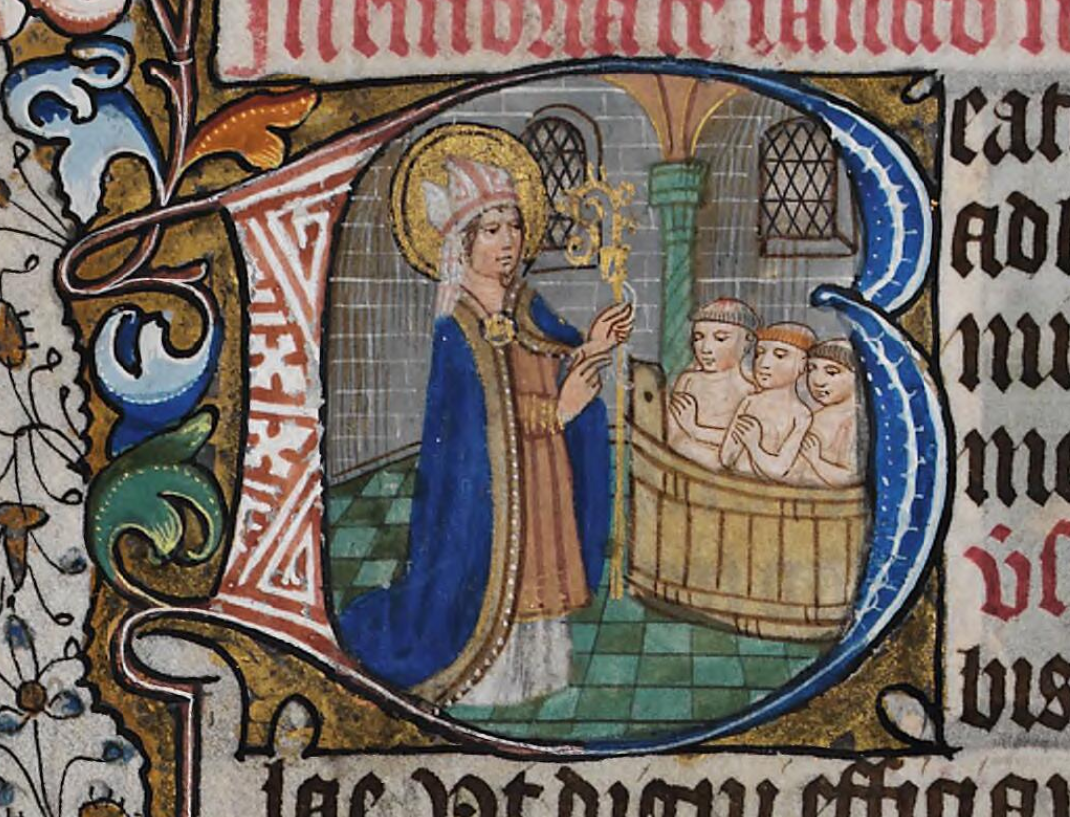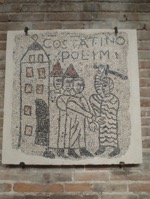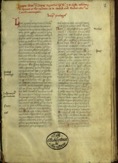The development of the appearance of the modern Santa Claus is a fascinating one, evolving from traditional representations in Germany and the Low Countries, a distinctly English Father Christmas, and the Coca-Cola Company’s efforts to sell product. One of the most distinctive features of the modern portrayal, though, predates all of these: the beard, a sine qua non of the modern depiction, dates back centuries, and likely originated with the historical St. Nicholas himself. Unlike some of the other aspects of his appearance, though, the decision of St. Nicholas (probably) to wear a beard, and the decisions of his later iconographers to depict him with one (or not, as the case may be), were generally not socially or theologically neutral. In this post, I’d like to explore some aspects of the meaning conveyed by St. Nick’s beard, focusing mostly on the Middle Ages and as an excuse to bring up my favorite research topic: the differences that arose between Latin and Greek expressions of Christianity during and after the conflict of the mid-eleventh century.
But first, by way of background, what can be said about the appearance of the historical St. Nicholas, the bishop of Myra in Asia Minor in the first half of the fourth century? While the sources for the general practice of the time period are not unanimous, the consensus of the Christian writers of the period, especially in the Eastern part of the Roman Empire, seems to have been in favor of beard-wearing [1]. Clement of Alexandria, writing the century prior, argued, “For God wished the woman to be hairless and smooth, rejoicing in her hair alone, like the horse does its mane, but He decorated man with a beard, just like the lions” [2]. Nor was the sentiment confined to Christian authors. Emperor Julian (“the Apostate” or “the Philosopher” depending on whom you ask), about as un-Christian an author as one could ask for and a reasonably close contemporary of Nicholas, is famous for his written defense of the beard. At the same time, clergy in many parts of the West, and the city of Rome in particular, retained the republican and imperial Roman custom of cleanshavenness.
The preference of the Eastern churchmen has been taken into account for forensic reconstructions done on the basis of the relics in his tomb in Bari, and the resulting depiction is dominated by a sizeable beard ]. This depiction persisted in subsequent centuries of Greek Christian iconography. From the earliest surviving example (seventh or eighth century, available in the Mount Sinai Archives), through to the present day, St. Nicholas, in the Greek tradition, is consistently depicted with a beard. And, given his ubiquity in the medieval and modern Orthodox church setting, it might be fair to say that he became one of the definitive archetypes for how clergy should look.

Public domain, via Wikimedia Commons.
Clerical appearance took on a new significance as conflicts between the Greek and Latin churches began to arise. During the so-called “Photian Schism” in the ninth century, for example, while Photios himself noted the differences between Greek and Latin practices with equanimity, other Greeks were less tolerant [3]. The Roman Pope at the time, Nicholas I, complained to Hincmar of Reims that the Greeks condemned them for being clean shaven [4]. By the time of the legation of 1054, this condemnation had grown into an occasional cause for a break in communion. As Humbert of Silva Candida complained: “maintaining the hair of their head and their beards, they [i.e., the Greeks] do not receive into communion those who tonsure their hair and shave their beards according to the institution of the Roman Church” [5].
The Latins, as mentioned above, were much friendlier to the notion of cleanshavenness as far back as the Patristic period, especially among the clergy, and this permissiveness gradually evolved into a situation in which not having a beard became one of the defining markers of the clerical state. Even within monastic communities, wearing a beard was a sign of the low social standing of lay brothers in religious communities. Monks who were also ordained, in contrast, were usually clean shaven [6]. Defenders of the Latin tradition, therefore, predictably took a very different position from their Greek interlocutors. This expression ranged from the mild-mannered observation of the difference in practice made by the Norman Anonymous, writing around the turn of the twelfth century (“they observe a different custom in tonsure and habit […], for they are bearded”) to the vituperative Leo Tuscus half a century later (“Their priests, in a Jewish manner, permit their beards to grow, which are sodden with the Lord’s blood when it is drunk by them.”) [7].
So what of St. Nicholas? While the Greeks continued to portray him in the traditional manner, Latin artists (or perhaps iconographers?) chose to portray him not as he was, but as they felt he ought to have been. The Nicholas that emerges in the late Middle Ages looks every bit the part of a Latin bishop: in Latin clerical dress, complete with miter and crosier, and without a trace of a beard.

Of course, it is important to note that St. Nicholas was hardly alone in this treatment: it was entirely commonplace to update the saints of antiquity to suit the sartorial standards of the artist. At the same time, precious few saints with so wide a following in the Latin Church were known to be Greek, and the Greek preference for the beard was equally well known, so it’s difficult not to see some degree of deliberate Latinization in the portrayal of the saint.
In the end, East-West polemic shifted to other topics, clearing the way for the restoration of the beard. And, in a sense, in fixing the image of a bearded Santa Claus so firmly in the modern imagination, to the point that a beardless Santa Claus would be near anathema, perhaps the Coca-Cola Company has earned a small debt of gratitude from contemporary iconographers.
Nick Kamas
PhD in Medieval Studies
University of Notre Dame
[1] A. Edward Siecienski, “Holy Hair: Beards in the Patristic Tradition” St Vladimir’s Theological Quarterly 58:1 (2014), 64.
[2] Clement of Alexandria, Paidogogus 3.3. PG 8.580.
[3] Photius of Constantinople, The Mystagogy of the Holy Spirit, trans. Holy Transfiguration Monastery (Long Island City, NY: Studion Publishers, 1983), 45–46. For a discussion of this and many of the following sources, see A. Edward Siecienski, Beards, Azymes, and Purgatory: The Other Issues that Divided East and West (Oxford: Oxford University Press, 2023), 38–78.
[4] PP Nicholas I, Epistola Hincmaro et Ceteris Confratribus Nostris Archiepiscopis et Episcopis in Regno Karoli Gloriosi Regis […], MGH Epistolae VI, 603.
[5] “Excommunicatio qua feriuntur Michael Caerularius atque ejus sectatores.” Acta et Scripta, ed. Cornelius Will (Frankfurt am Main: Minerva GMBH, 1963), 153–154.
[6] Giles Constable, The Reformation of the Twelfth Century (Cambridge: Cambridge University Press, 1996), 195–196.
[7] Norman Anonymous. “De consecratione sacerdotis,” in Die Texte des Normannischen Anonymus, ed. Karl Pellens (Wiesbaden: Franz Steiner Verlag, 1966), 104. Leo Tuscus, Malae consuetudines Graecorum, PG 140.547D.



